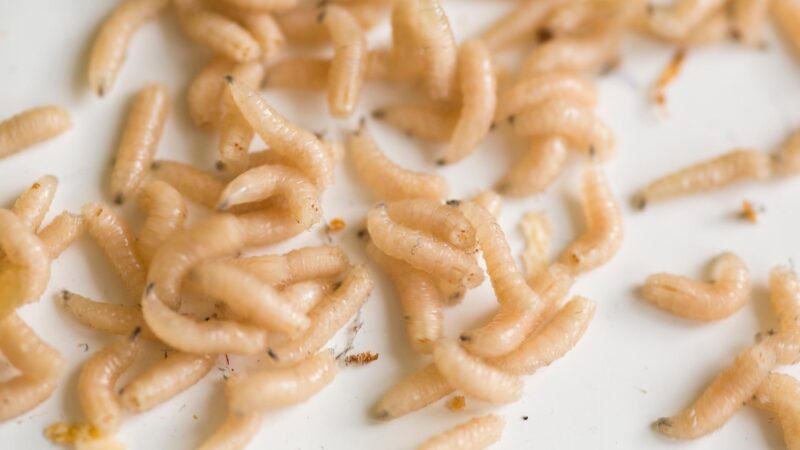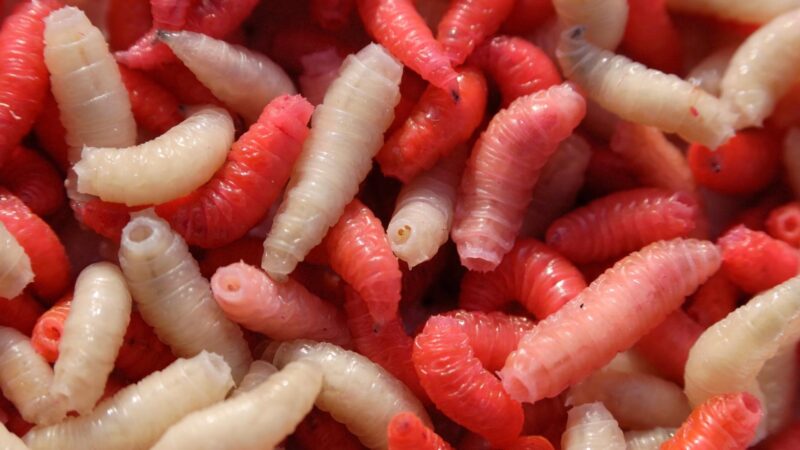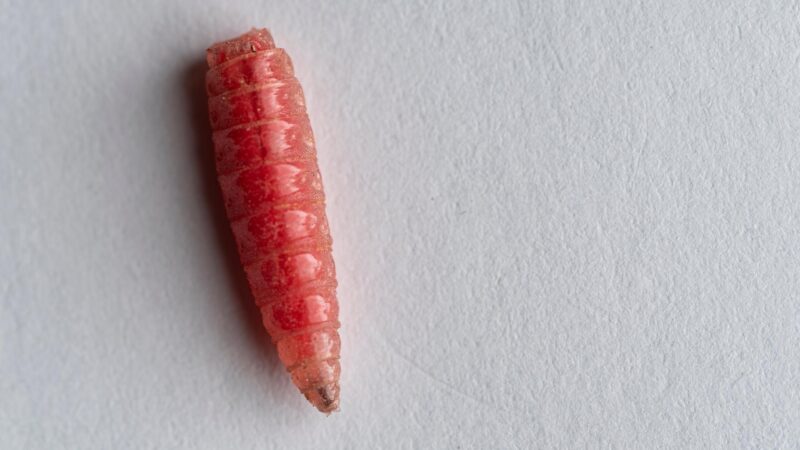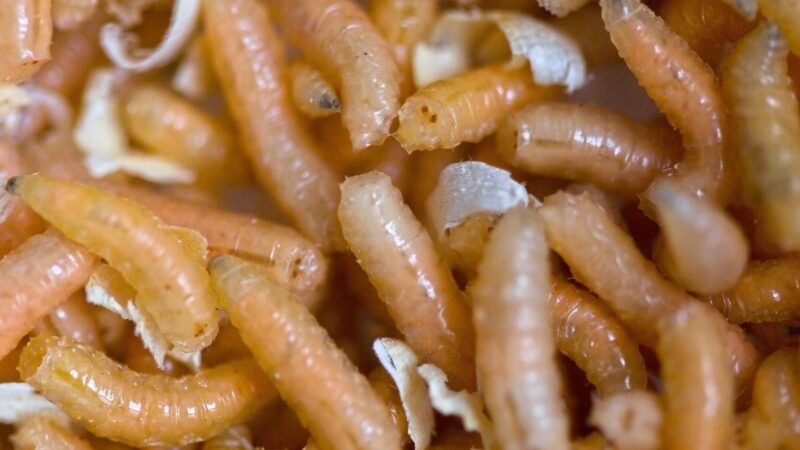Maggots are fly larvae, which turn into pupae before they become adults. As we all know, flies are common nuisance pests indoors and outdoors.
Both adult flies and larvae feed on garbage and have become a huge part of our daily lives. They may also contaminate food and transmit diseases to humans and pets.
Do all maggots turn into flies? All maggots turn into flies unless they are dead. Most maggots come from eggs and are in the second life stage of flies. Nonetheless, some fly species give birth to maggots, usually one at a time. Newborn maggots will hide underground until they are ready to emerge as flies.
Flies, especially houseflies, are known for transmitting serious diseases such as typhoid fever, cholera, and E. coli. On the other hand, maggots can cause an infection called Myiasis once swallowed.
Fortunately, this comprehensive guide will teach you everything about flies and maggots, and how to get rid of them.
Table of Contents
How Do Maggots Turn Into Flies | Life Cycle

Most fly species undergo complete metamorphosis, which means they pass through four life stages – egg, larval, pupal, and adult stages. On average, a complete life cycle may take 1-3 weeks. Depending on the weather, each female can lay about 100 to 150 eggs in several batches, usually within 3 to 4 days.
Female flies lay their eggs once they land in warm, moist, organic materials such as garbage, human and animal waste, lawn clippings, contaminated soil, decaying fruits and vegetables, and dead animals.
During favorable conditions, these fly eggs will hatch into legless maggots between 8 and 20 hours.
Young housefly larvae are usually creamy white, 3 to 9 mm (3/32 to 3/8 inches) long, with a cylindrical body but tapering towards their head and a pair of dark hooks.
Maggots undergo three larval instar stages before they become pupae, which are about 8 mm (5/16 inches) long and will grow inside a cocoon.
The pupae will develop into adults usually within 2-6 days at 32 to 37°C (89.6 to 98.6°F) or within 17 to 27 days if the temperature is about 14°C (57.2°F).
But while all maggots turn into flies after passing through the pupal stage, some fly species such as tsetse flies give birth to live maggots instead of laying eggs.
How Long Does It Take Maggots to Turn Into Flies?
At optimal temperatures, housefly maggots complete their larval stages in 4-13 days. But if the temperature is between 12 and 17°C (53.6 and 62.6°F), their development into pupae may be from 14 to 30 days.
Therefore, maggots will turn into flies between 16 and 57 days, depending on the temperature and nutrition.
What Causes Flies and Maggots in the Bathroom?

Some fly species, such as drain flies and their maggots, are in the bathroom because it is one of their natural habitats. Also called moth flies, drain flies deposit their eggs in shallow, polluted, or muddy water.
Moth fly maggots feed on decaying organic material, especially in kitchen sinks and bathroom drains.
Where Did the Flies and Maggots Come From?
According to popular belief, flies and maggots come from nothing. But as mentioned earlier, some fly species lay eggs while others give birth to live maggots because their eggs are laid and hatched inside their bodies.
On the other hand, all adult flies emerge from the pupal stage in the breeding material.
If Flies Lay Maggots, Where Do Baby Flies Come From?
Regardless of whether flies give birth to maggots or lay eggs, baby flies don’t exist. There is no such thing as a baby fly simply because flies that emerge from being pupae are already full-grown.
Nevertheless, the term “baby fly” can be referred to as legless maggots, which look very differently from adult flies.
Do Flies Drop Maggots When They Rub Their Legs?

Flies don’t drop maggots when they rub their legs. Instead, flies are grooming themselves to sharpen their senses in flying, finding food and mates, etc.
They rub their legs over their antennae to remove particulates such as dust particles. This cleaning behavior is common to many fly species, especially houseflies.
Do Dead Flies Turn Into Maggots?
Dead flies don’t turn into maggots. Once a fly is dead, it will no longer go back to life. Instead, their bodies will slowly decompose, although the exoskeleton lasts a lot longer.
Dead flies may also be eaten by other organisms. In some cases, the bacteria living inside the carcass will start to digest the body tissues.
Can Maggots Bite You?

Maggots cannot bite you since they don’t have teeth. However, maggots can enter a human body if a person eats spoiled food heavy-infested by maggots.
Accidental eating of maggots may kill the maggots during food digestion but can lead to bacterial poisoning, especially if the maggots are infected with diseases.
What Can Maggots Eat Through?
Maggots eat almost all kinds of foods available to them, including spoiled food, garbage, and human tissue. Aside from accidental swallowing, maggots can enter human bodies through open wounds, where flies lay their eggs.
Maggots that survive will feed on the body tissue and can cause Myiasis infection.
Which Family of Flies Is Used as Surgical Maggots?
Blow fly maggots are the ones being used as surgical maggots. Despite being creepy and disgusting creatures, these maggots are known for performing the so-called maggot debridement therapy (MDT).
Interestingly, sterilized maggots of blow flies have been used to clean and disinfect wounds for several centuries.
French physician and surgeon Ambroise Paré was the first one to have observed and documented maggot therapy in the 1500s.
However, it was only during the 1920s when American orthopedic surgeon William Baer started to develop this odd but clinically-approved maggot therapy. MDT is now being used worldwide.
How to Get Rid of Flies and Maggots?
Generally speaking, flies don’t bite, but they can carry bacteria and viruses and can transmit diseases to humans and pets. Once ignored, they can reproduce quickly, and maggots will be an added danger to public health.
To avoid a potential fly infestation, here are some ways to get rid of flies and maggots:
- Place electric fans on fly-infested areas.
- Check hidden areas for possible dead rats or waste and dispose of them immediately.
- Vacuum the areas where you see maggots and throw away the vacuum bag properly.
- Alternatively, pour boiling water or vinegar solution on them.
- Sprinkle food-grade diatomaceous earth (DE) on maggot-infested areas.
- A study suggested that some essential oils can repel flies and maggots. This includes essential oil from cinnamon, lavender, neem, sunflower, tea tree, and vetiver.
- Place non-toxic sticky fly traps such as Kensizer 20-Pack Window Fly Traps on areas where flies accumulate.
- Alternatively, use fly traps with attractants such as Safer Brand Victor Fly Magnet Reusable Trap with Bait.
- If there are only a few flies, use heavy-duty fly swatters with long handles such as Kensizer Plastic Fly Swatters. To avoid contamination, don’t use them near food preparation areas.
Related: How to Eliminate a Fly Infestation in House? | A Detailed Guide
How to Get Rid of Flies and Maggots on Garbage?
Garbage is one of the favorite breeding sites of flies since trash cans contain rotten organic matter, which is the most preferred food for maggots. Ignoring garbage will cause fly infestations, no matter how hard you control flies indoors. Here are some effective ways to get rid of flies and maggots on garbage:
- Check your garbage for leftover foods and food wrappers, and separate them right away.
- To dehydrate maggots, sprinkle lime and salt on your garbage.
- Clean your garbage cans with bleach or vinegar solution, and make sure the lids are always closed tightly.
- Don’t wash your garbage cans in the soil full of earthworms and organic matter.
What Spray Kills Maggots?
Maggots don’t have wings, but they can hide in very tiny gaps. But because traps are very unlikely to work effectively against them, you might want to use sprays instead. Since sprays are in liquid form, they evaporate, so you should spray repeatedly. Nevertheless, here are some sprays that kill maggots instantly:
- Vinegar solution
- Boric acid solution
- Dishwashing soap and hot water
- Essential oils, especially cinnamon and lavender
- Aerosol sprays such as P&G Professional MICROBAN Aerosol Disinfectant Spray
- Insecticide sprays with permethrin such as Gordon Permethrin 10
What Keeps Flies and Maggots Away?
Without flies, maggots will not exist. Therefore, the best way to get rid of maggots is to control flies. But since flies are very stubborn pests, you should not give them reasons to be present.
Below are some simple tips to keep flies and maggots away and help prevent them from coming back:
- Remove their source of food and breeding areas. This includes keeping the surroundings clean and dry by proper disposal of organic waste, animal feces, kitchen waste, and rotting fruit.
- Store food in airtight containers and get only what you can consume.
- If you or any of your household members have an open wound, cover it with a bandage.
- Don’t include meat, fish, and leftover food in your garbage.
- Clean your garbage cans thoroughly at least once a week.
- Maggots are attracted to moisture, so put some silica packets at the bottom of your garbage cans.
- Avoid feeding your pets outdoors. If you do, remove their bowls immediately after eating.
- For exterior lighting, use yellow light bulbs instead of blue ones.
- Always keep your doors and window screens closed. If there is damage, repair or replace it as soon as possible.
- If possible, install mechanically-designed doors that close automatically.
- Check for wall cracks, crevices, and tiny gaps, and cover them with foam insulation such as Loctite TITE FOAM Insulating Foam Sealant.
- Hang UV light traps such as Gardner FlyWeb Classic Fly Light in dark areas where flies cannot see them from the outside.
- In your backyard, plant plants that repel flies such as cinnamon and sunflower. You might also want to plant perennial carnivorous plants such as Venus flytrap.
Summary
Flies are filthy pests, while maggot populations increase rapidly. Getting rid of them can be challenging, and some control methods should be done together. But still, using insecticides indoors can pose health risks, so make sure you follow instructions religiously. So far, proper sanitation is the best preventive method.